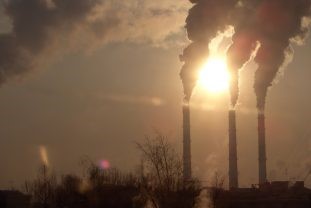
 March 2012 • Tribune 32 •
March 2012 • Tribune 32 •
The European Union has committed to cut GHG (GreenHouse Gases) emissions by 8% by 2012 and by 20% by 2020. To help meet those targets, a financial instrument in the form of a cap and trade scheme, known under the acronym “EU ETS” (EU Emission Trading System), was adopted at the Environment Council of October 13, 2003. It was then launched on January 1, 2005. Following a “testing period” (2005-2007), the second phase will come to an end this year (2008-2012).
The EU ETS sets a cap on the amount of CO2 that can be emitted. Companies or sectors of activities are given, under the trading system, credits or allowances (one allowance -EUA- equals one ton of CO2) which represent the right to emit a specific amount. Companies that exceed their limit (cap) must buy allowances from those who emit less or if they don’t they have to pay heavy penalties.
So a market for allowances emerged and trading platforms developed. Nowadays not only over-the-counter operations take place but also standardized spot and future contracts are concluded every day. Several private trading platforms co-exist, including Bluenext, Climex and so on. Bluenext is the leading spot exchange for EUAs. It is a multilateral trading facility, a joint venture of the NYSE and Caisse de Dépôts (a French financial institution).
Under this trading system, the EU Member States agree on national emission caps which have to be approved by the EU Commission. The allowances resulting from this agreement are allocated by each EU Member State to its industrial companies. The operators within the ETS scheme may reassign or trade their allowances directly or through brokers listed on the exchanges. The national registry and the European Commission are informed of each change of ownership in order for them to validate the transaction. However there is currently an initiative to centralize the allocation of EUAs under one Authority.
Following sectors are covered by the directive:
- Power and heat generation over 20 MWth
- Oil refineries
- Cokes, iron and steel production
- Glass production
- Pulp and paper
- Ceramics
- Lime and cement production
The number of allowances allocated to each emitter (i.e. the number of tons of carbon dioxide to be authorized for emission) is set out in National Allocation Plans (NAP) prepared by the Member States and approved by the Commission. In practice, each Member State has to establish an electronic register in which each installation has an account (the operator holding account). The competent Authority in each state is responsible for the issuance of allowances to the holding account. No allowances can be distributed before a plan has been accepted and approved by the Commission. However the Commission authority is limited. For example, the European court of first instance ruled that the Commission had exceeded its powers in 2007 by rejecting the NAP of Poland and Estonia. The Commission had cut the NAP figures by around 27% and 48% respectively. This leads to uncertainty. On the one hand the NAP figures need to be approved by the Commission before entering into force. Yet the Commission cannot impose a figure.
During the first phase, a minimum of 95% of the total amount of allowances had to be allocated for free. In the second phase, this amount is down to 90%.
For the 3d phase, starting in 2013, the EU comes up with a number of changes to the scheme, including:
- centralized allocation (no more national allocation plan) by an EU authority;
- the setting of an overall EU cap, with allowances then allocated to Member States;
- tighter limits on the use of offsets;
- unlimited banking of allowances between phases 2 and 3;
- a move from free allowances to auctioning a greater share of permits. Sectors and sub-sectors significantly exposed to carbon leakage (see hereinunder) qualify for support in the form of allowances that would otherwise be auctioned.
In any case the ETS scheme is expensive. According to Mr Nobutani, “Japan’s wealth has been drawing out due to buying carbon credits from East European countries and China”. A Japanese survey estimates that Japan has paid as much as USD 10.4 billion to buy 400 million metric tons of carbon credits.
The EU also agreed to incorporate flexible mechanism certificates as compliance tools within the EU ETS like the Joint Implementation (JI) and the Clean Development Mechanism (CDM) which produces Certified Emission Reductions (CERs). One CER represents the successful emission reduction equivalent to 1 ton of carbon dioxide equivalent. CERs can be obtained by implementing emission reduction projects in developing countries (carbon offset) that have ratified or acceded to the Kyoto protocol. UNFCCC ( United Nations Framework Convention on Climate Change), a body of the UN, has the task of monitoring and approving the CDM.
Between 2008 and 2020, the ETS allows the use of international credits for up to 50% of overall reductions.
Some CDM-projects (among others HFC gas projects) have long been criticized by environmental organizations. They claim that said projects do not really lead to lower emissions but are only carried out to generate credits. They have been accused of “gaming” the system. The EU Commissioner Connie Hedegaard wants to ban credits from such industrial projects even if they are approved by the UNFCCC.
There are indeed perverse incentives. For example, one Chinese company generated USD 500 million in carbon offsets by installing a USD 5 million incinerator to burn the HFC produced by the manufacture of refrigerants. The huge profits provided incentives to create new factories or expand existing factories solely for the purpose of increasing the production of HFC and destroying the resultant pollutants to generate offsets.
On the other hand, China, the world’s top polluter, appears to be benefiting most from the ETS scheme.
The European Commission is aiming at a major overhaul of the Clean Development Mechanism.
[…]
